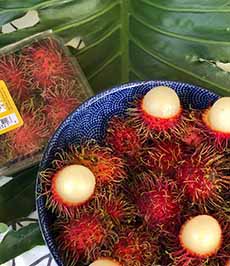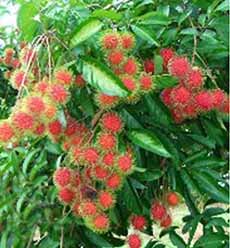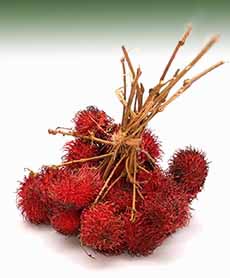TIP OF THE DAY: Rambutan, Asian Fruit
|
|
Great news for lovers of sweet fruits like lychees: For the next three weeks, from from August 22nd to September 14th, shoppers will be able to find rambutans on store shelves. Rambutans are the sweet berries of a tropical tree. The berries have an unusual appearance: The red peel is covered with soft red or green “hairs.” In fact, the name “rambutan” is derived from the Malay word rambut, meaning hair. Similarly, in Vietnam, its name is chôm chôm, meaning messy hair. Like lychees, rambutans have translucent white pulp (sometimes pale pink), with a large, nut-like, inedible seed. Eat them chilled, if you can resist popping them open before they hit the fridge. Rambutan is sweet and refreshing, with a flavor reminiscent of lychee crossed with grape. Even though they are satisfyingly sweet, rambutans only have around 10 calories per berry. They are also very convenient for grab-and-go: They are easy to peel and eat. Look for rambutans at Freshfields Farms, Meijer, Trader Joe’s, Wal-Mart and Whole Foods stores. For more information, visit HLBSpecialties.com or call (954) 475-8808. Rambutans, Nephelium lappaceum, are native to the Malay Archipelago. They grow on a tree in the family Sapindaceae or soapberry—so-called because the oil from the seeds of these plants contains saponin, which is used as a natural, low-sudsing detergent. The family also includes lychee, longan, guarana, and the horse chestnut and maple trees, among other genuses. Growing wild in Indonesia and Malaysia, rambutans have been cultivated for thousands of years. Arab traders and others carried the fruits to other parts of Asia, then to Africa, Central America, Colombia and Ecuador and Oceania. Seeds were imported into the U.S. from Java in 1906, but the trees, which want hot, humid climates, did not grow successfully in this country. Before 2016, rambutans were virtually unknown in the U.S. outside of Asian grocers. HLB Specialties introduced a rambutan clamshell to supermarkets at that time, and the fruit quickly gained a following. But it’s only around for a few short weeks, so “follow” quickly. |
|
|
RAMBUTAN NUTRITION The rambutan fruit is rich in vitamins and minerals, including the antioxidant vitamin C. Eating 5–6 rambutans (easy to do!) provides 50% of the daily nutrition value of C. Its flesh provides around 1.3–2 grams of total fiber per 3.5 ounces (100 grams), similar to apples, pears and oranges. Rambutan also has a good amount of copper, an essential nutrient*. It has smaller amounts of calcium, iron, magnesium, manganese, phosphorus, potassium and zinc, as well. At only 10 calories per fruit, what are you waiting for? *Together with iron, copper enables the body to form red blood cells. It helps maintain healthy bones, blood vessels, nerves, and immune function.
|
||





